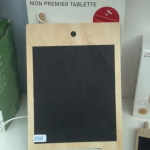 It’s easy to forget that what now seems low tech was once high tech. Such is the nature of our relationship with technology. We want the next big thing, but in order to justify getting it, what we have now must feel dated. It can be enlightening – and fun – for students to trace the steps as a technology evolves. What do we gain at each step that makes us covet the newest version? Or, in other words, how does innovation happen?
It’s easy to forget that what now seems low tech was once high tech. Such is the nature of our relationship with technology. We want the next big thing, but in order to justify getting it, what we have now must feel dated. It can be enlightening – and fun – for students to trace the steps as a technology evolves. What do we gain at each step that makes us covet the newest version? Or, in other words, how does innovation happen?
Let’s look, for example, at the leap from simple slate boards and chalk to Magic Slates – those cardboard pads covered with a gray plastic film that we used to doodle on using a plastic stylus (or sometimes just our fingernail). The “magic” occurred when we lifted the plastic film with a magician’s flourish, making all traces disappear, and leaving us a clean slate to create with once again. The main advantage of the high tech version, for teachers and parents at least, was avoiding messy chalk dust. For children, however, the novelty was the tactile pleasure it offered. Jumping many steps forward to the iPad, we can sense that it has a certain “retro” feel, reminiscent of its ancestor the Magic Slate, caused by the replacement of a keyboard with a touch screen. This evolution shows us how important it is not to forget earlier forms of technology since innovation often circles backward before moving forward.
Along these lines, here are four presentational speaking and/or writing topics to help students think critically and creatively about technology as a cultural product linked to practices and perspectives. Alternatively, students could use any of these topics as the basis for an interview with a native speaker and then present their findings. For an added twist, you might consider having students use both low and high tech tools to present (e.g., combining cue cards with PowerPoint slides for presentational speaking; handwriting segments using a variety of implements and surfaces and then photographing and digitally combining the texts for presentational writing).
Tech Inventory: Do an inventory of your home (or classroom). Identify and describe the oldest form of technology that is still in use (you may need to do research online to date it). Who uses this technology? Is there a newer technology available to accomplish the same tasks? If so, why do you think this technology is still being used? (Variation: Identify and describe the oldest form of technology that is no longer in use. Who last used it? How, when, and for what purpose did they use it? Why is it no longer used? Why do you think it is still in your home/classroom even though it’s not being used?)
Then and Now: Choose a form of technology that you use frequently or that intrigues you and compare an early version of it with a later one (e.g., a mode of transportation, a household appliance, a cooking gadget, a toy, a communication tool, etc.). Compare and contrast the features of each version. What are their advantages and disadvantages? Is the older version obsolete? Is it a collector’s item? ¬Are there any aspects of the older version that the newer version hasn’t improved upon? Which version do you prefer? Why?
Game Changer: Tell/write about how your life (and/or the life of your family) was changed by a new form of technology. What was your life like before this technology? How/why/when did it come into your life? What technology (if any) did it replace? How did it change your life (for better and for worse)?
#nostalgia: Describe a technology from your childhood that you miss using. How, when and with whom did you use it? What feelings do you associate with it? Why was it important to you? What (if anything) replaced it?

